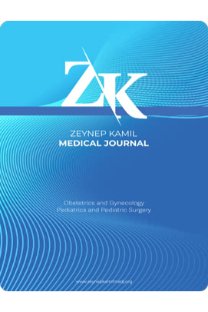Postmenopozal smearlerin servikal intraepiteliyal neoplazi yönünden değerlendirilmesi
Postmenopoz, Vajinal smirler, Servikal intraepitelyal neoplazi, Geriyedönük çalışma
Evaluation of postmenopausal smears with regard to cervical intraepithelial neoplasia
___
- 1. Disaia Creasman, Clinical gynecologic oncology. Sixth edition. 2002;1-4 2. Sebbelov AM, Kjorstad KE, Abeler VM, Norrild B. The prevalence of HPV type 16 and 18 DNA cervical cancer in different age groups: a study on the incidental cases of cervical cancer in Norway in 1983. gynecol Oncol. 1991:41:141-148
- 3. Schneider A, Koutsky LA. Natural history and epidemiological features of genital HPV infection.In: Munoz N,Bosh FX,Shah KV, Meheus A,eds. The epidemiology of cervical cancer dnd human papillomavirus. Lyon: International Agency for Cancer Research, 1992;25-52
- 4. Mandelblatt J, Schecter C, Fahs M, Muller C
- Clinical implications of screening for cervical cancer under Medicare. The natural history of cervical cancer in the elderly: what do we know? What do we need to know? Am J Obstet Gynecol
- 1991;164: 644-651
- 5. Meijer CJL'M, van de Brule AJC, Snijders PJF, Helmefhorsi T, Kenemans P, Walboomers JMM
- Detection of human papillomavirus in cervical scrapes by the polimerase chain reaction in relation to cytology: possible implications for cervical cancer screening. In: Munoz N, Bosh FX, Shsh KV, Meheus A, eds. The epidemiology of cervical cancer and human papillomavirus. Lyon: International Agency for Cancer Research. 1992;271-281
- 6. Walton RI, Blanchet M, Boves DA et al. Cervical cancer screening programs. Can Med Assoc J. 1976; 114:1003-33
- 7. Roberts AD, Denholm RB, CordinerJW. Cervical intraepithelial neoplasia in postmenopausal women with negative cervical cytology. Br Med J. 1985; 290:281
- 8. Barron BA, Richard RM. Statistical model of the natural history of cervical carcinoma: estimate of the transition time from dyplasia to carcinoma insitu. J Natl Cancer Inst 1970; 45: 1025-30
- 9. Gerbaldo D, Cristoforoni P, Leone M, Casciaro L, Baracchini P, Fulcheri E. The incidental finding of abnormal cervical histology in postmenopausal patients. Maturitas. 1995; 21:115-120
- ISSN: 1300-7971
- Yayın Aralığı: 4
- Başlangıç: 1969
- Yayıncı: Ali Cangül
Yenidoğan konvülsiyonlarının değerlendirilmesi
Feza AKSOY, Ayça VİTRİNEL, Serdar CÖMERT, YASEMİN AKIN, ZEYNEP NAGEHAN YÜRÜK YILDIRIM
Gebelikte mitral kapak replasmanı: Olgu sunumu
Asuman SÜZER, Türkan ÇORUH, NİHAN YAPICI, Sonay CİVELEK, Sabri DAĞSALI, Zuhal AYKAÇ
Kontrolsüz D vitamini kullanımı ile oluşan iatrojenik hiperkalsemi: Olgu sunumu
Özahi İlke İPEK, Rabia Gönül SEZER, Pulat Lale SEREN, Abdülkadir BOZAYKUT
Primer tubal adenokarsinom: 3 olgu sunumu
Ceyhun NUMANOĞLU, Özgür AKBAYIR, Nevin NUMANOĞLU, Onur EROL, Engin ODABAŞ, Ahmet GÜLKILIK
Levent TÜTÜNCÜ, Murat MUHCU, Selami SÜLEYMANOĞLU, Ercüment MÜNGEN
Tibolonun transdermal östradiol tedavisiyle yükselmiş serum lipoprotein (a) düzeylerine etkisi
Süha SÖNMEZ, LEVENT YAŞAR, Asiye TOKLAR, Yakup ŞENSOY, Ziya ÇEBİ, Serdar KOÇ, Latif KÜPELİOĞLU, Fehmi YAZICIOĞLU, Kamil KURT
Preterm doğum eyleminde maternal serum AFP ve hCG düzeyleri
Deniz KÖSE, Hüsamettin USLU, Akın VARLIK, Arzu AYDIN, Akif ALKAN
Postmenopozal smearlerin servikal intraepiteliyal neoplazi yönünden değerlendirilmesi
Ceyhun NUMANOĞLU, Altuncu Nevin NUMANOĞLU, İbrahim POLAT, Ahmet GÜL, Onur EROL, Ahmet GÜLKILIK
LEVENT YAŞAR, Süha SÖNMEZ, Yakup ŞENSOY, kadir SAVAN, Osman ÖZYURT, Ziya ÇEBİ, Fehmi YAZICIOĞLU, Mehmet AYGÜN, Sefa KELEKÇİ
Kliniğimizde izlenen kabakulak meningoensefalitli olguların değerlendirilmesi
Özlem BOSTAN, Boylu Selda AĞZIKURU, Sedat ÖKTEM, Gülnur TOKUÇ, Ayça VİTRİNEL, Engin TUTAR, Özlem KETENCİ
